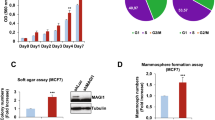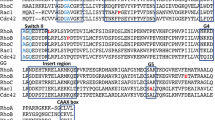Abstract
RhoA organizes actin stress fibres and is necessary for cell transformation by oncogenes such as src and ras. Moreover, RhoA is implicated in cadherin clustering during the formation of adherens junctions. The catenin p120 has also been implicated in cadherin clustering through an unknown mechanism. Here we show that p120 selectively inhibits RhoA activity in vitro and in vivo. RhoA inhibition and the interaction of p120 with cadherins are mutually exclusive, suggesting a mechanism for regulating the recruitment and exchange of RhoA at nascent cell–cell contacts. By affecting RhoA activation, p120 could modulate cadherin functions, including suppression of invasion, neurite extension and junction formation.
This is a preview of subscription content, access via your institution
Access options
Subscribe to this journal
Receive 12 print issues and online access
$209.00 per year
only $17.42 per issue
Buy this article
- Purchase on Springer Link
- Instant access to full article PDF
Prices may be subject to local taxes which are calculated during checkout





Similar content being viewed by others
References
Takeichi, M. Morphogenetic roles of classic cadherins. Curr. Opin. Cell Biol. 7, 619–627 ( 1995).
Yap, A. S. The morphogenetic role of cadherin cell adhesion molecules in human cancer: a thematic review. Cancer Invest. 16, 252 –261 (1998).
Frixen, U. H. et al. E-cadherin-mediated cell-cell adhesion prevents invasiveness of human carcinoma cells. J. Cell Biol. 113, 173–185 (1991).
Perl, A. K., Wilgenbus, P., Dahl, U., Semb, H. & Christofori, G. A causal role for E-cadherin in the transition from adenoma to carcinoma. Nature 392, 190– 193 (1998).
Vleminckx, K., Vakaet, L., Jr., Mareel, M., Fiers, W. & van Roy, F. Genetic manipulation of E-cadherin expression by epithelial tumor cells reveals an invasion suppressor role. Cell 66, 107–119 (1991).
Anastasiadis, P. Z. & Reynolds, A. B. The p120 catenin family: complex roles in adhesion, signalling and cancer. J. Cell Sci. 113, 1319–1334 ( 2000).
Nobes, C. C. & Hall, A. Rho, Rac, and Cdc42 GTPases regulate the assembly of multimolecular focal complexes associated with actin stress fibres, lamellipodia, and filopodia. Cell 81, 53–62 (1995).
Braga, V. M., Machesky, L. M., Hall, A. & Hotchin, N. A. The small GTPases Rho and Rac are required for the establishment of cadherin-dependent cell-cell contacts. J. Cell Biol. 137, 1421 –1431 (1997).
Takaishi, K., Sasaki, T., Kotani, H., Nishioka, H. & Takai, Y. Regulation of cell–cell adhesion by rac and rho small G proteins in MDCK cells. J. Cell Biol. 139, 1047–1059 (1997).
Jou, T.S. & Nelson, W.J. Effects of regulated expression of mutant RhoA and Rac1 small GTPases on the development of epithelial (MDCK) cell polarity. J. Cell Biol. 142, 85– 100 (1998).
Kaibuchi, K., Kuroda, S., Fukata, M. & Nakagawa, M. Regulation of cadherin-mediated cell-cell adhesion by the Rho family GTPases. Curr. Opin. Cell Biol. 11, 591–596 (1999).
Reynolds, A. B., Daniel, J. M., Mo, Y. Y., Wu, J. & Zhang, Z. The novel catenin p120cas binds classical cadherins and induces an unusual morphological phenotype in NIH3T3 fibroblasts. Exp. Cell Res. 225, 328–337 ( 1996).
Sekimata, M., Kabuyama, Y., Emori, Y. & Homma, Y. Morphological changes and detachment of adherent cells induced by p122, a GTPase-activating protein for Rho. J. Biol. Chem. 274, 17757– 17762 (1999).
Kranenburg, O. et al. Activation of RhoA by lysophosphatidic acid and Galpha12/13 subunits in neuronal cells: induction of neurite retraction. Mol. Biol. Cell 10, 1851–1857 (1999).
Chrzanowska-Wodnicka, M. & Burridge, K. Rho-stimulated contractility drives the formation of stress fibres and focal adhesions. J. Cell Biol. 133, 1403–1415 (1996).
An, S., Goetzl, E. J. & Lee, H. Signalling mechanisms and molecular characteristics of G protein-coupled receptors for lysophosphatidic acid and sphingosine 1-phosphate . J. Cell Biochem. Suppl. 31, 147– 157 (1998).
Dong, J. M., Leung, T., Manser, E. & Lim, L. cAMP-induced morphological changes are counteracted by the activated RhoA small GTPase and the Rho kinase ROKalpha. J. Biol. Chem. 273, 22554– 22562 (1998).
Ramakers, G. J. A. & Moolenaar, W. H. Regulation of astrocyte morphology by RhoA and lysophosphatidic acid. Exp. Cell Res. 245, 252–262 ( 1998).
Debant, A. et al. The multidomain protein Trio binds the LAR transmembrane tyrosine phosphatase, contains a protein kinase domain, and has separate rac- specific and rho-specific guanine nucleotide exchange factor domains. Proc. Natl Acad. Sci. USA 93, 5466–5471 (1996).
Sasaki, T. & Takai, Y. The Rho small G protein family-Rho GDI system as a temporal and spatial determinant for cytoskeletal control . Biochem. Biophys. Res. Commun. 245, 641 –645 (1998).
Olofsson, B. Rho guanine dissociation inhibitors: pivotal molecules in cellular signalling . Cell Signal. 11, 545– 554 (1999).
Mariner, D. J., Wang, J. & Reynolds, A. B. ARVCF localizes to the nucleus and adherens junction and is mutually exclusive with p120ctn in E-cadherin complexes . J. Cell Sci. 113, 1481– 1490 (2000).
Ren, X. D., Kiosses, W. B. & Schwartz, M. A. Regulation of the small GTP-binding protein Rho by cell adhesion and the cytoskeleton. EMBO J. 18, 578–585 (1999).
Thoreson, M. A. et al. Selective uncoupling of p120(ctn) from E-cadherin disrupts strong adhesion. J. Cell Biol. 148, 189– 202 (2000).
Hirao, M. et al. Regulation mechanism of ERM (ezrin/radixin/moesin) protein/plasma membrane association: possible involvement of phosphatidylinositol turnover and Rho-dependent signalling pathway. J. Cell Biol. 135, 37–51 (1996).
Kotani, H., Takaishi, K., Sasaki, T. & Takai, Y. Rho regulates association of both the ERM family and vinculin with the plasma membrane in MDCK cells . Oncogene 14, 1705–1713 (1997).
Keirsebilck, A. et al. Molecular cloning of the human p120ctn catenin gene (CTNND1): expression of multiple alternatively spliced isoforms. Genomics 50, 129–146 ( 1998).
Kinch, M. S., Clark, G. J., Der, C. J. & Burridge, K. Tyrosine phosphorylation regulates the adhesions of ras-transformed breast epithelia. J. Cell Biol. 130, 461–471 (1995).
Calautti, E. et al. Tyrosine phosphorylation and src family kinases control keratinocyte cell–cell adhesion. J. Cell Biol. 141, 1449–1465 (1998).
Ozawa, M. & Kemler, R. The membrane-proximal region of the E-cadherin cytoplasmic domain prevents dimerization and negatively regulates adhesion activity. J. Cell Biol. 142, 1605 –1613 (1998).
Aono, S., Nakagawa, S., Reynolds, A. B. & Takeichi, M. p120(ctn) acts as an inhibitory regulator of cadherin function in colon carcinoma cells. J. Cell Biol. 145, 551– 562 (1999).
Takeuchi, K. et al. Perturbation of cell adhesion and microvilli formation by antisense oligonucleotides to ERM family members. J. Cell Biol. 125, 1371–1384 ( 1994).
Mackay, D. J., Esch, F., Furthmayr, H. & Hall, A. Rho- and rac-dependent assembly of focal adhesion complexes and actin filaments in permeabilized fibroblasts: an essential role for ezrin/radixin/moesin proteins. J. Cell Biol. 138, 927–938 (1997).
Lampugnani, M. G. et al. Cell confluence regulates tyrosine phosphorylation of adherens junction components in endothelial cells. J. Cell Sci. 110, 2065–2077 (1997).
Reynolds, A. B. et al. Identification of a new catenin: the tyrosine kinase substrate p120cas associates with E-cadherin complexes. Mol. Cell. Biol. 14, 8333–8342 ( 1994).
Wu, J., Mariner, D. J., Thoreson, M. A. & Reynolds, A. B. Production and characterization of monoclonal antibodies to the catenin p120ctn . Hybridoma 17, 175–183 (1998).
Zhang, B., Zhang, Y., Collins, C.C., Johnson, D. I. & Zheng, Y. A built-in arginine finger triggers the self-stimulatory GTPase- activating activity of rho family GTPases. J. Biol. Chem. 274, 2609–2612 ( 1999).
Li, R., Zhang, B. & Zheng, Y. Structural determinants required for the interaction between Rho GTPase and the GTPase-activating domain of p190. J. Biol. Chem. 272, 32830–32835 ( 1997).
Li, R. & Zheng, Y. Residues of the Rho family GTPases Rho and Cdc42 that specify sensitivity to Dbl-like guanine nucleotide exchange factors. J. Biol. Chem. 272, 4671– 4679 (1997).
Acknowledgements
A.B.R. was supported in part by NIH grant CA55724 and by the Ingram-Vanderbilt Cancer Center through the Cancer Center support grant CA69485. Y.Z. was supported by NIH grant GM53943. We thank M.A. Schwartz for the GST–RBD construct, M. Symons for Rho family GTPase constructs and helpful discussions and J.M. Daniel for the p120–GST construct and general support.
Author information
Authors and Affiliations
Corresponding author
Rights and permissions
About this article
Cite this article
Anastasiadis, P., Moon, S., Thoreson, M. et al. Inhibition of RhoA by p120 catenin. Nat Cell Biol 2, 637–644 (2000). https://doi.org/10.1038/35023588
Received:
Revised:
Accepted:
Published:
Issue Date:
DOI: https://doi.org/10.1038/35023588
This article is cited by
-
CAR links hypoxia signaling to improved survival after myocardial infarction
Experimental & Molecular Medicine (2023)
-
3D cell segregation geometry and dynamics are governed by tissue surface tension regulation
Communications Biology (2023)
-
Rebalancing of actomyosin contractility enables mammary tumor formation upon loss of E-cadherin
Nature Communications (2019)
-
E-cadherin roles in animal biology: A perspective on thyroid hormone-influence
Cell Communication and Signaling (2016)
-
Beyond β-catenin: prospects for a larger catenin network in the nucleus
Nature Reviews Molecular Cell Biology (2016)



